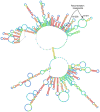Mutability dynamics of an emergent single stranded DNA virus in a naïve host
- PMID: 24416396
- PMCID: PMC3885698
- DOI: 10.1371/journal.pone.0085370
Mutability dynamics of an emergent single stranded DNA virus in a naïve host
Abstract
Quasispecies variants and recombination were studied longitudinally in an emergent outbreak of beak and feather disease virus (BFDV) infection in the orange-bellied parrot (Neophema chrysogaster). Detailed health monitoring and the small population size (<300 individuals) of this critically endangered bird provided an opportunity to longitudinally track viral replication and mutation events occurring in a circular, single-stranded DNA virus over a period of four years within a novel bottleneck population. Optimized PCR was used with different combinations of primers, primer walking, direct amplicon sequencing and sequencing of cloned amplicons to analyze BFDV genome variants. Analysis of complete viral genomes (n = 16) and Rep gene sequences (n = 35) revealed that the outbreak was associated with mutations in functionally important regions of the normally conserved Rep gene and immunogenic capsid (Cap) gene with a high evolutionary rate (3.41×10(-3) subs/site/year) approaching that for RNA viruses; simultaneously we observed significant evidence of recombination hotspots between two distinct progenitor genotypes within orange-bellied parrots indicating early cross-transmission of BFDV in the population. Multiple quasispecies variants were also demonstrated with at least 13 genotypic variants identified in four different individual birds, with one containing up to seven genetic variants. Preferential PCR amplification of variants was also detected. Our findings suggest that the high degree of genetic variation within the BFDV species as a whole is reflected in evolutionary dynamics within individually infected birds as quasispecies variation, particularly when BFDV jumps from one host species to another.
Conflict of interest statement
Figures




Similar articles
-
REPEAT SPILLOVER OF BEAK AND FEATHER DISEASE VIRUS INTO AN ENDANGERED PARROT HIGHLIGHTS THE RISK ASSOCIATED WITH ENDEMIC PATHOGEN LOSS IN ENDANGERED SPECIES.J Wildl Dis. 2020 Oct 1;56(4):896-906. doi: 10.7589/2018-06-154. J Wildl Dis. 2020. PMID: 33600597
-
Evidence of psittacine beak and feather disease virus spillover into wild critically endangered Orange-bellied Parrots (Neophema chrysogaster).J Wildl Dis. 2014 Apr;50(2):288-96. doi: 10.7589/2013-05-121. Epub 2014 Jan 31. J Wildl Dis. 2014. PMID: 24484492
-
The phylogenetic and recombinational analysis of beak and feather disease virus Taiwan isolates.Arch Virol. 2016 Nov;161(11):2969-88. doi: 10.1007/s00705-016-2963-z. Epub 2016 Jul 7. Arch Virol. 2016. PMID: 27388370
-
Beak and feather disease virus in wild and captive parrots: an analysis of geographic and taxonomic distribution and methodological trends.Arch Virol. 2016 Aug;161(8):2059-74. doi: 10.1007/s00705-016-2871-2. Epub 2016 May 5. Arch Virol. 2016. PMID: 27151279 Free PMC article. Review.
-
[Research advances in the Cap gene of circovirus and its encoding capsid protein].Bing Du Xue Bao. 2013 Jun;29(4):465-70. Bing Du Xue Bao. 2013. PMID: 23895015 Review. Chinese.
Cited by
-
Genome Sequences of Beak and Feather Disease Virus in Urban Rainbow Lorikeets (Trichoglossus haematodus).Genome Announc. 2015 Apr 23;3(2):e00283-15. doi: 10.1128/genomeA.00283-15. Genome Announc. 2015. PMID: 25908126 Free PMC article.
-
Whole-Genome Sequence of a Beak and Feather Disease Virus Isolate from a Fledgling Red-Capped Parrot (Purpureicephalus spurius).Genome Announc. 2016 Oct 13;4(5):e01108-16. doi: 10.1128/genomeA.01108-16. Genome Announc. 2016. PMID: 27738029 Free PMC article.
-
Lesions and viral loads in racing pigeons naturally coinfected with pigeon circovirus and columbid alphaherpesvirus 1 in Australia.J Vet Diagn Invest. 2023 May;35(3):278-283. doi: 10.1177/10406387231156839. Epub 2023 Mar 10. J Vet Diagn Invest. 2023. PMID: 36896657 Free PMC article.
-
Production and immunogenicity of a plant-produced beak and feather disease virus vaccine in Japanese quails.Arch Virol. 2025 Jun 25;170(7):163. doi: 10.1007/s00705-025-06352-z. Arch Virol. 2025. PMID: 40560236 Free PMC article.
-
Genomic Characterisation of a Highly Divergent Siadenovirus (Psittacine Siadenovirus F) from the Critically Endangered Orange-Bellied Parrot (Neophema chrysogaster).Viruses. 2021 Aug 28;13(9):1714. doi: 10.3390/v13091714. Viruses. 2021. PMID: 34578295 Free PMC article.
References
-
- Shearer PL, Bonne N, Clark P, Sharp M, Raidal SR (2008) Beak and feather disease virus infection in cockatiels (Nymphicus hollandicus). Avian Pathol 37: 75–81. - PubMed
-
- Pass DA, Perry RA (1984) The pathology of psittacine beak and feather disease. Aust Vet J 61: 69–74. - PubMed
-
- Ritchie B, Niagro F, Latimer K, Lukert P, WL S, et al. (1990) Ultrastructural, protein composition, and antigenic comparison of psittacine beak and feather disease virus purified from four genera of psittacine birds. J Wildl Dis 26: 196–203. - PubMed
-
- Ritchie BW, Niagro FD, Lukert PD, Steffens Iii WL, Latimer KS (1989) Characterization of a new virus from cockatoos with psittacine beak and feather disease. Virology 171: 83–88. - PubMed
-
- Raidal SR, McElnea CL, Cross GM (1993) Seroprevalence of psittacine beak and feather disease in wild psittacine birds in New South Wales. Aust Vet J 70: 137–139. - PubMed
Publication types
MeSH terms
Substances
LinkOut - more resources
Full Text Sources
Other Literature Sources
Miscellaneous

